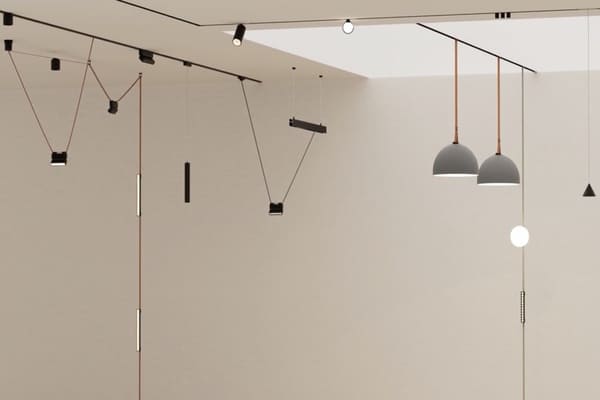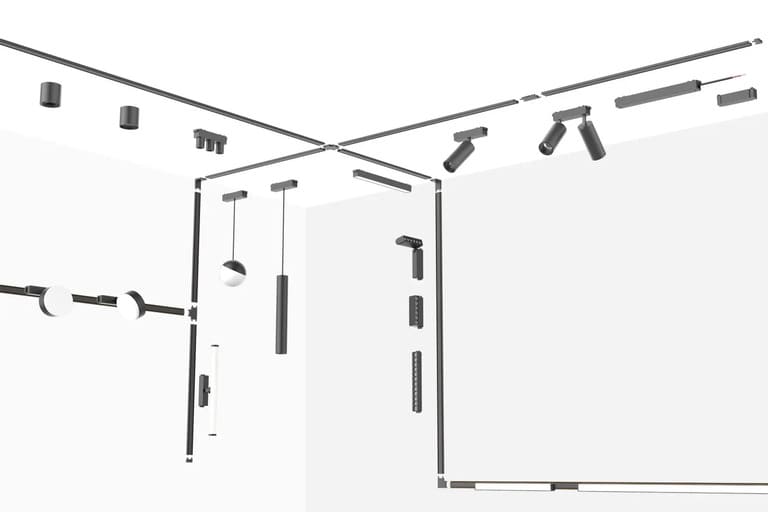If your lighting project demands flexibility, fast installation, and a sleek design, but you’re overwhelmed by options—you’re not alone.
Magnetic track lighting systems offer a flexible, modular, and efficient solution that adapts to various commercial and residential applications.
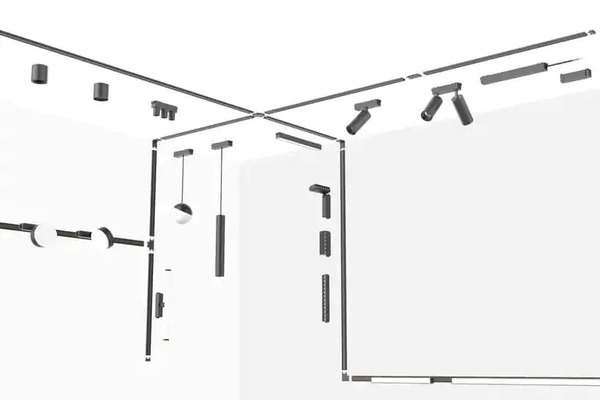
When I started working with lighting systems, I struggled to explain to clients why some lights suited their space better than others. Once I discovered magnetic track systems, things changed. Their design, ease of use, and performance made them easier to recommend and customize for many projects.
What Is Magnetic Track Lighting and How Does It Work?
Trying to wire multiple lights or adjust ceiling lighting can feel complicated—especially when layout changes mid-project.
Magnetic track lighting works by using a low-voltage magnetic connection (typically 48V) between the light fixture and the track, allowing fast, tool-free repositioning of lights.
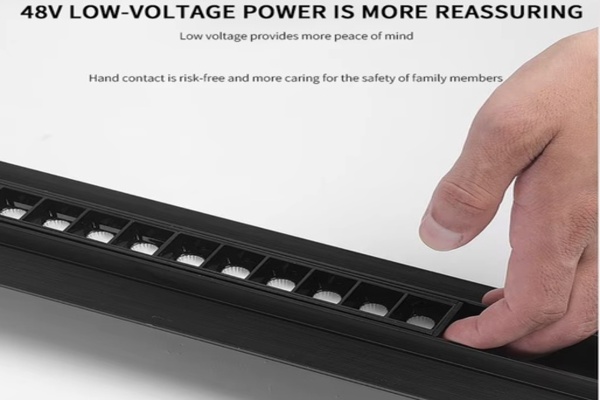
The Magnetic Concept Made Simple
Each track is powered by a low-voltage driver. Inside the rail, copper conductors carry electricity. Light modules with built-in magnets “snap” into place, maintaining secure contact while still allowing repositioning. Most systems use 48V DC power, which is safe and ideal for interior spaces.
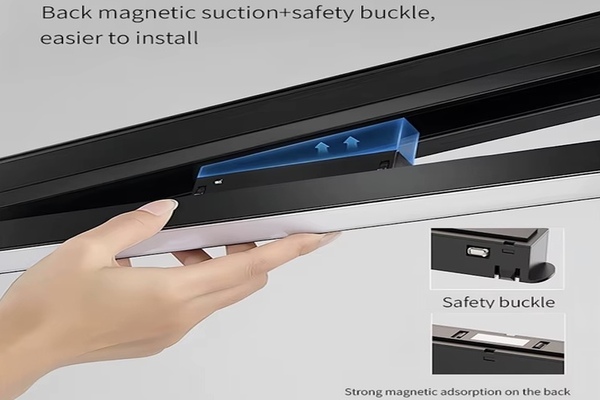
There are three main mounting styles: recessed, surface-mounted, and suspended. Tracks come in linear, L-shape, or custom layouts. Most systems allow the integration of different modules—spotlights, linear floodlights, pendant lights—all interchangeable. A standard connector can link tracks to form longer runs or shapes.
This structure makes magnetic systems highly modular, ideal for evolving layouts like retail displays or exhibition halls.
What Are the Benefits of Using Magnetic Track Lighting?
Sometimes clients ask why they should switch from traditional fixtures. I usually say: “Because you’ll save time, reduce costs long-term, and get design flexibility from day one.”
Magnetic track lighting offers benefits like easy installation, tool-free adjustment, modularity, energy savings, and minimalistic design that fits both residential and commercial spaces.
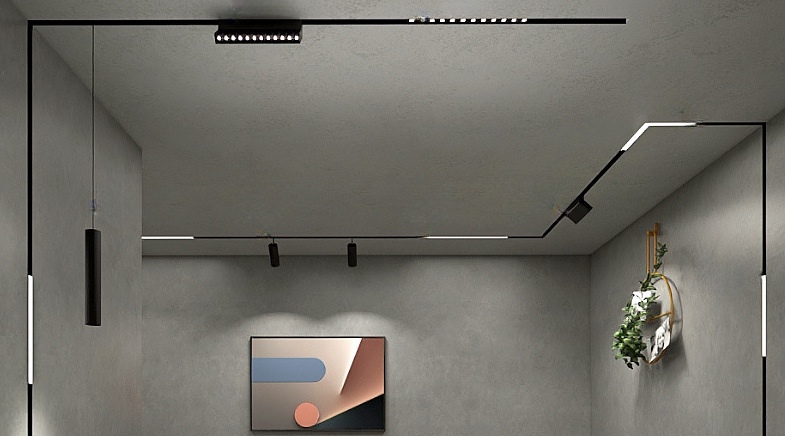
Key Benefits at a Glance
| Benefit | Description |
|---|---|
| Tool-free installation | No screws or drilling once the rail is mounted. Just snap in the light modules. |
| Flexible repositioning | Easily move or add lights as your space layout changes. |
| Modular design | Combine spotlights, linear floods, and pendants on one track. |
| Slim, modern look | Minimalist design blends into architectural spaces. |
| Safe low voltage | Operates at 48V DC, safer and more efficient. |
| Dimmable + Smart Ready | Compatible with 0-10V, DALI, or Zigbee systems. |
In my own projects, I’ve seen how retail spaces benefit from the ability to change display lighting layouts weekly. With traditional track lights, you’d need an electrician. With magnetic lights, even store staff can adjust the layout on their own.
How to Install Magnetic Track Lighting Systems?
Installing lighting can sound technical. But magnetic systems are different—much easier and safer than most people think.
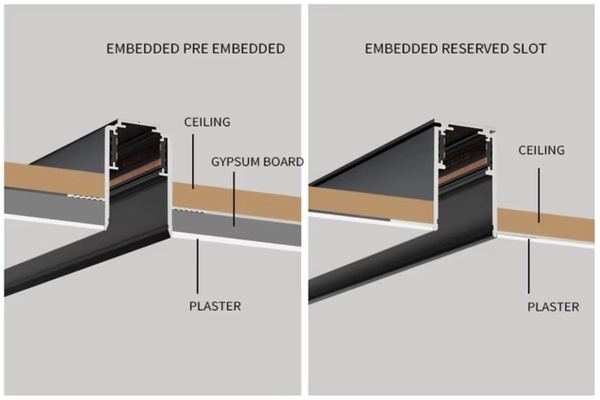
Magnetic track lights can be installed using recessed, surface, or suspended mounting methods and connect to 48V DC power via a driver, requiring no tool to attach the lights themselves.
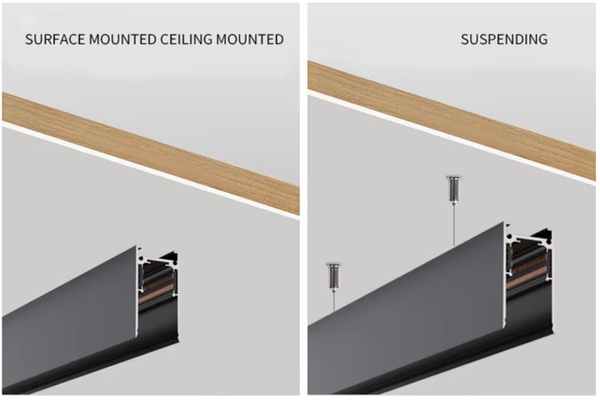
Step-by-Step Installation Overview
| Step | Description |
|---|---|
| 1. Choose mounting type | Recessed into ceiling, surface-mounted, or suspended from wires. |
| 2. Install track rails | Align and fix rails using mounting brackets or clips. |
| 3. Connect power driver | Use a 48V DC constant voltage driver, usually hidden in ceiling. |
| 4. Snap in modules | Place the spotlights, linear lights, or pendants into track—magnet holds them securely. |
| 5. Test the system | Power on and check each light module for proper function. |
Once, in a high-end fashion store installation, the layout changed last minute. We didn’t need to rewire or call an electrician. I just moved the spotlight modules to match the new display.
Where Can Magnetic Track Lighting Be Used Effectively?
Clients often ask me, “Is this light suitable for my project?” I usually respond, “It depends where—but it fits more places than you’d expect.”
Magnetic track lighting is ideal for retail stores, galleries, offices, hotels, and modern residential interiors because it adapts easily to layout changes and design preferences.
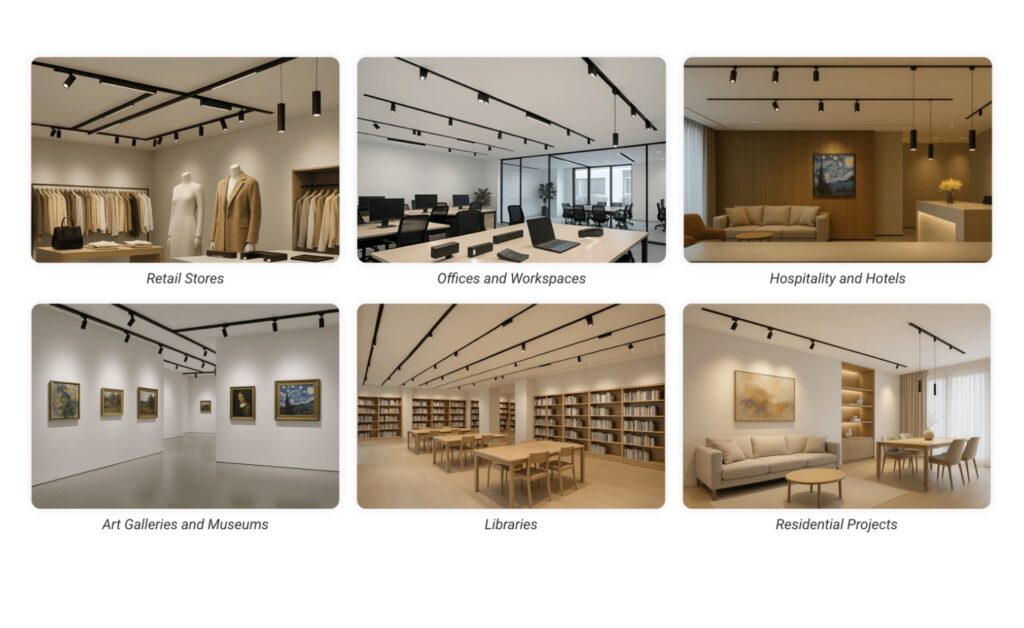
Common Application Scenarios
| Location | Use Case |
|---|---|
| Retail Stores | Highlight changing product displays with adjustable spotlights. |
| Art Galleries | Use precise beams and low glare to illuminate artwork. |
| Offices | Combine general lighting and focused lighting in open-plan layouts. |
| Hotels | Install in lobbies, corridors, and rooms for clean, upscale ambiance. |
| Residences | Apply in living rooms, kitchens, or bedrooms for minimalist design. |
One of my clients—a furniture retailer—was amazed by how quickly they could update their lighting during seasonal store changes. They didn’t need a full lighting redesign or external contractors.
What Should You Consider When Choosing Magnetic Track Lighting?
At first glance, magnetic track lights all seem similar. But choosing the wrong spec can ruin a great space.
Key considerations include voltage (typically 48V), light module compatibility, dimming control, certification, mounting type, and the quality of magnetic connection.
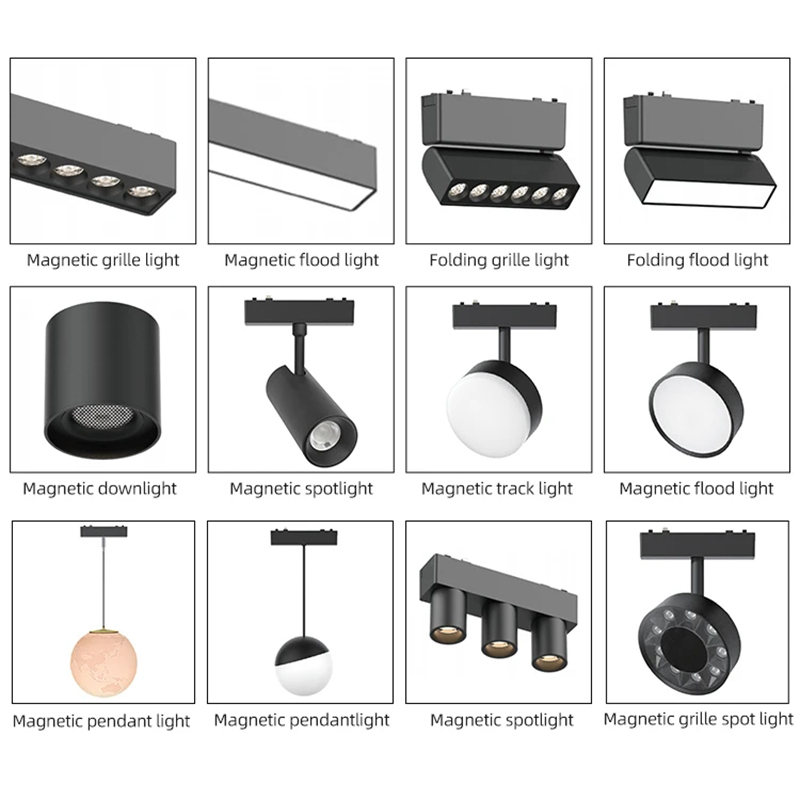
How to Evaluate Before You Buy
| Factor | Why It Matters |
|---|---|
| Voltage & Driver | Most systems run on 48V DC. Make sure your power setup supports it. |
| Track Compatibility | Not all modules fit all tracks. Stick to one system or brand. |
| Light Module Type | Choose based on beam angle, function (spotlight vs flood), and color temperature. |
| Dimming Options | Check if it supports 0-10V, DALI, TRIAC, or smart control. |
| Certification | Look for CE, RoHS, UL, or SAA if exporting or using in regulated markets. |
| Mounting Preference | Recessed gives a clean look; surface or pendant fits exposed ceilings. |
A client once ordered from two suppliers—modules didn’t fit. They had to discard half the order. If we had worked together from the start, we could have saved that cost.
Are Magnetic Track Lighting Systems Energy Efficient?
Energy savings matter—especially when your clients run large offices, hotels, or retail chains. Every watt counts when multiplied across hundreds of fixtures.
Yes, magnetic track lighting is energy-efficient due to low-voltage operation, LED technology, and advanced dimming systems that reduce power usage while maintaining lighting quality.
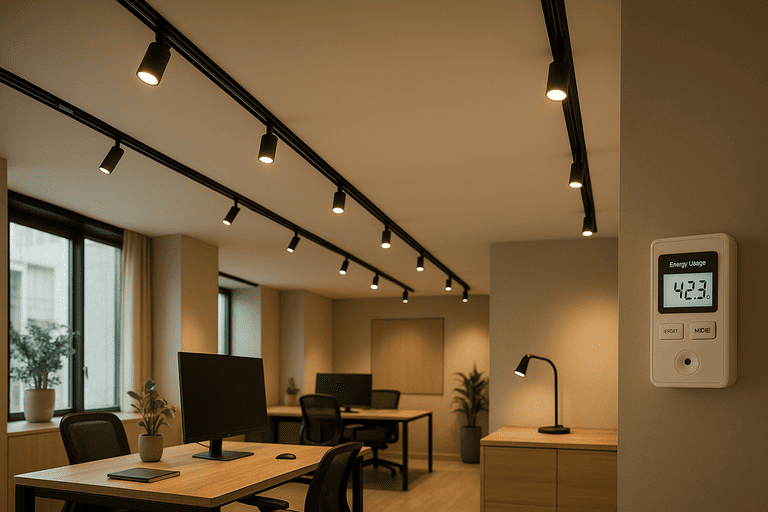
Why Magnetic Lighting Saves Power
| Feature | Impact |
|---|---|
| LED Source | Most magnetic modules use high-efficiency LEDs (110–140 lm/W). |
| Low Voltage (48V DC) | Reduces power loss across the system and increases driver efficiency. |
| Dimming Support | 0–10V, TRIAC, or DALI dimming reduces brightness and energy use when not needed. |
| Directional Lighting | Focused beams minimize wasted light, improving use-per-lumen. |
| Integrated Smart Control | Allows motion or daylight sensors to reduce unnecessary usage. |
A small art gallery I worked with saw a 17% drop in lighting-related electricity costs after switching to magnetic lighting—no loss in brightness, just smarter use.
Can Magnetic Track Lighting Be Customized for Different Spaces?
Clients who design luxury stores or boutique hotels often want unique layouts. They ask me: “Can this lighting system be tailored to our space?” Absolutely.
Magnetic track lighting is highly customizable—layouts, lengths, module types, color temperatures, and finishes can all be adjusted to match different environments and preferences.
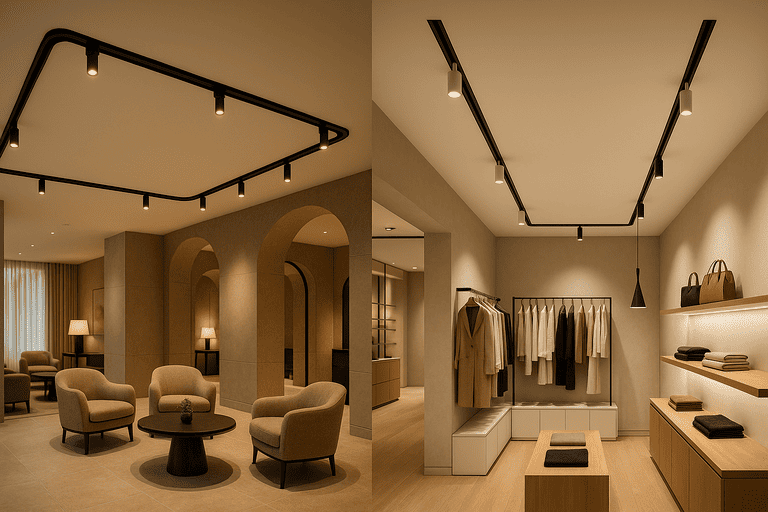
Customization Options That Matter
| Customizable Element | Application |
|---|---|
| Track Length & Shape | Tailor to U-shape, L-shape, grid, or linear arrangements. |
| Module Selection | Choose from spotlights, floodlights, wall washers, pendants. |
| Color Temperature | Offer 2700K–6000K options, or use DIP switch for adjustable CCT. |
| Finish & Housing Color | Match ceiling color with matte black, white, or metallic finishes. |
| Smart Control Integration | Add Zigbee, Casambi, or Bluetooth for app control. |
A cosmetic brand client needed uniform stores worldwide. We custom-made white matte tracks and warm 3500K CCT—now part of their global identity.
What Are the Common Challenges with Magnetic Track Lighting and How to Overcome Them?
Magnetic lights sound perfect, but like any system, they have limits. Clients who know this upfront avoid costly mistakes.
Common issues include weak magnets, incompatible modules, driver mismatch, or poorly designed tracks. Choosing a reliable manufacturer solves most of these problems.
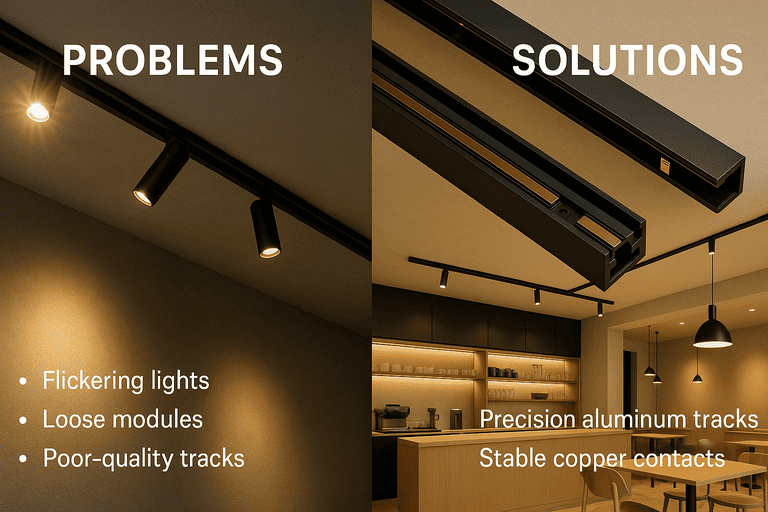
Problems and Practical Fixes
| Problem | Solution |
|---|---|
| Weak Magnetism | Use industrial-grade magnets and verify holding force during testing. |
| Track Compatibility | Stick with one system brand to avoid fitting issues. |
| Driver Issues | Match LED driver specs (48V DC constant voltage) to the system. |
| Track Quality Variance | Ensure tracks are aluminum with precision machining for proper fit. |
| Module Loose Contact | Use tracks with stable copper contact design to reduce flicker or disconnection. |
A café we helped had flickering lights from cheap online kits. We replaced only the rails—and everything worked perfectly. Reliable tracks matter just as much as the lamps themselves.
Conclusion
Magnetic track lighting systems combine flexibility, safety, and modern design. With the right choices, they can upgrade any space—and save time, energy, and future costs.


